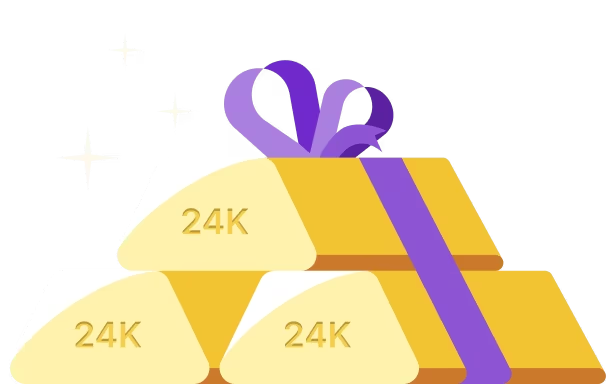When it comes to financial freedom, there are a lot of different opinions out there. Some believe it's simply about not having to work a 9-to-5 job.
In contrast, others believe it is about having enough money to live comfortably without worrying about it ever again.
So, what is financial independence all about? There are many myths about this. It is mainly because of the lack of financial literacy.
So, in this blog post, we'll take a closer look at what financial freedom means and whether it's achievable.
We'll also explore some key steps you can take to start working towards financial freedom. So, let's get started!
What is the true essence of financial freedom?
Financial freedom is about so much more than just having no job. It's about having a financial cushion that allows you to afford a certain lifestyle and have a nest egg for retirement without the need to earn a salary.
It's about being smart about investing your money to save for your future and retire comfortably.
It's also about being able to give back to the community and make a difference in the world.
There are several ways to achieve financial freedom, and it's up to you to decide what's best for you.
You can invest in real estate, start a business, or even be smart with your money and live below your means.
No matter what you do, remember that financial freedom is the ultimate goal.
Steps to become financially independent
Regardless of your definition of financial freedom, here are 6 steps to attain it and become financially independent in the long run.
Step 1: Take inventory & organize finances
To most people, the idea of attaining financial freedom is pretty appealing. After all, who wouldn't want to be free from the 9-to-5 grind and have more time and money to do the things they love?
The first step to becoming financially independent is to take inventory of your current financial situation.
Many people overlook this step, but knowing where your money is going and how much you can save will give you a brief idea of how long it will take you to achieve true financial freedom.
This includes taking a look at your take-home income and monthly expenses. Go through your bank statements, credit card statements, and other financial documents that are in your possession.
Sitting down with a financial advisor who can help you make sense of the numbers and answer any questions you may have is also a good idea.
They will help you organize your finances by looking for more productive and sustainable ways to boost income or cut back on expenses.
Step 2: Manage cash flow & become debt-free
One of the most important steps is to understand your cash flow. This means knowing how much money is coming in every month and where you're spending them.
A person living paycheck-to-paycheck might think their financial situation is all under control when they are just one emergency away from bankruptcy or foreclosure.
Debt is an anchor that weighs you down and keeps you from being financially free. Many factors can cause a person to fall into the debt trap, be it credit card debt, loans, or mortgages.
The most common is lack of money, overspending, impulsive spending behaviors, and not saving enough to cover expenses. If you are not careful, it can become a never-ending cycle.
Therefore, it is essential to know what their spending habits look like so you can make changes if necessary. Some of the common ways to break the debt trap are:
- Pay off your total balance in full every month.
- Set up an auto-debit system with your bank or credit card company.
- If you are neck-deep in debt and unable to pay it off, negotiate with your creditors to either lower the interest rate or increase the duration.
- Transfer balances from high-interest credit cards to low-interest cards. If you opt for it for the first time, you can get an introductory offer of 0% APR for the first 18 months.
- Get a low-interest secured loan.
- Make extra monthly payments on your debts to get rid of them quickly.
Step 3: Prepare an emergency fund
It is crucial to prepare for emergencies in advance. They don't come with prior information.
A medical emergency can happen at any time and leave you with unexpected bills. It is the same for an unexpected job loss or other financial crisis.
This is why you should prepare for this eventuality by creating emergency funds.
Set aside money for at least 6-9 months' worth of your necessities in a separate, easy-to-withdraw account.
But that doesn't mean it just has to sit in some account and collect dust.
The smart step here is to invest your money where you can earn interest, such as in a liquid mutual fund.
Step 4: Set financial goals
Being financially free doesn't mean spending money aimlessly. It is essential to have financial goals. These goals have to be:
- Tangible
- Measurable
- Attainable
- Time-bound targets
Financial goals are also time-bound. They are:
- Short-term goals (1-3 years): Like saving for a marriage or vacation
- Medium-term goals (3-5 years): Like saving for a down payment on a house
- Long-term goals (10+ years): Saving for kids' education or marriage, retirement
Whatever your financial goals are, once you've identified them, estimate how much money you need to save and for how long.
Also, remember, while you are saving, consider the inflation rate too.
Step 5: Diversify your investments for greater wealth creation
When it comes to financial freedom, only saving money is not enough. Invest your money strategically to grow and create a wealth pool.
You can achieve this by having a truly diversified portfolio of investments that can provide you with the income you need to live the lifestyle you want.
Investing in various assets like the stock market, mutual funds (domestic and international), various government schemes, digital gold, real estate, etc., can minimize the risk of losing money and maximize your potential for wealth creation.
How investing in digital gold can build wealth for you?
Digital gold is a virtual investment asset, much more flexible and hassle-free than physical gold. It also acts as a hedge against inflation.
Digital gold offers easy liquidity and a great return on investment. And the best way to invest in digital gold is through the Jar app.
NPCI-authorized, Jar is like your virtual piggy bank where you can save as low as ₹10/day or ₹5,000/month.
The best thing is, you can save and invest effortlessly and withdraw whenever you want.
Once you download the Jar app, it scans your SMS folder to detect the payments you made for online purchases.
It then rounds off the amount nearest to 10 and generates a spare change for your expenses.
The app automatically deducts the change from your bank account using UPI to invest in 99.9% pure 24-carat digital gold in association with Safegold.
Step 6: Get insurance
According to the Financial Commission's report published in 2021, in India, 70% of expenditure on health is out of pocket, one of the highest globally.
That number is only going to increase in the coming years. But you don't have to suffer if you plan correctly.
Insurance is your best friend. It can protect your loved ones in case something happens to you and help you achieve financial freedom.
Make sure you get health insurance. You've probably heard this advice before and may have rejected it.
Don't take the chance of going without insurance, whether through your employer or personal coverage.
Life is unpredictable. If anything adverse happens to you, your family will suffer.
So, get your life insured and also ensure you get additional accident coverage.
If you have a car, make sure you get auto insurance. It will come in handy if you have an accident or need any major repair.
Renting? Look into affordable renters' insurance. Taking out a loan? Insure it.
The creditor may be able to collect the money from the insurance if you are unable to pay it or in the event of your death or permanent disability.
After all, being prepared is crucial to achieving financial freedom.
Conclusion
In conclusion, financial freedom is achievable if you develop a plan and stick to it.
Following the six steps, you can slowly but surely work towards a better and stress-free future.
However, remember that financial freedom is a journey, not a destination.
There will always be ups and downs, but as long as you stay the course, you will reach your goal.
Read other Jar blogs for great tips and tricks on personal finance.










